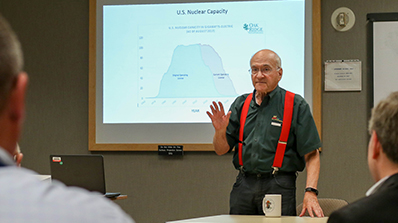Nevada National Security Site employees recently filled a conference room at their North Las Vegas Facility to hear Dr. Victor Reis’ presentation on “Stockpile Stewardship: History and Future.”
Dr. Reis, a retired senior Department of Energy advisor considered “the father of stockpile stewardship,” explained how the United States’ nuclear deterrence was the central focus of the Cold War, and nuclear testing was a focal point of nuclear weapon development. He also discussed how the end of the Cold War “brought major changes in the U.S. nuclear warhead program strategy.”
U.S. presidents from Eisenhower to Clinton seriously considered how to limit or stop nuclear explosive testing as part of arms control. With the end of the Soviet Union, President George H.W. Bush halted the development of new nuclear weapons. In 1993, President Clinton announced: “To assure that our nuclear deterrent remains unquestioned under a test ban, we will explore other means of maintaining our confidence in the safety, the reliability, and the performance of our own weapons.” Those “other means” became the Science-Based Stockpile Stewardship (SSBS) program.
Despite some political and technical bumps, SSBS has been successful for 25 years and remains the basis for the nuclear weapons strategy as described in the 2018 Nuclear Posture Review. The development of subcritical experiments (SCE) at the NNSS has taken on a central role in maintaining our confidence in the safety, reliability, and performance of our own nuclear weapons for an uncertain future.
“Integral SCEs are central to future SSBS [programs]. [That is the] U.S.’ nuclear deterrent strategy,” according to Dr. Reis.
A question-and-answer session addressed challenges of the nuclear scenario and Dr. Reis’ own experiences.

